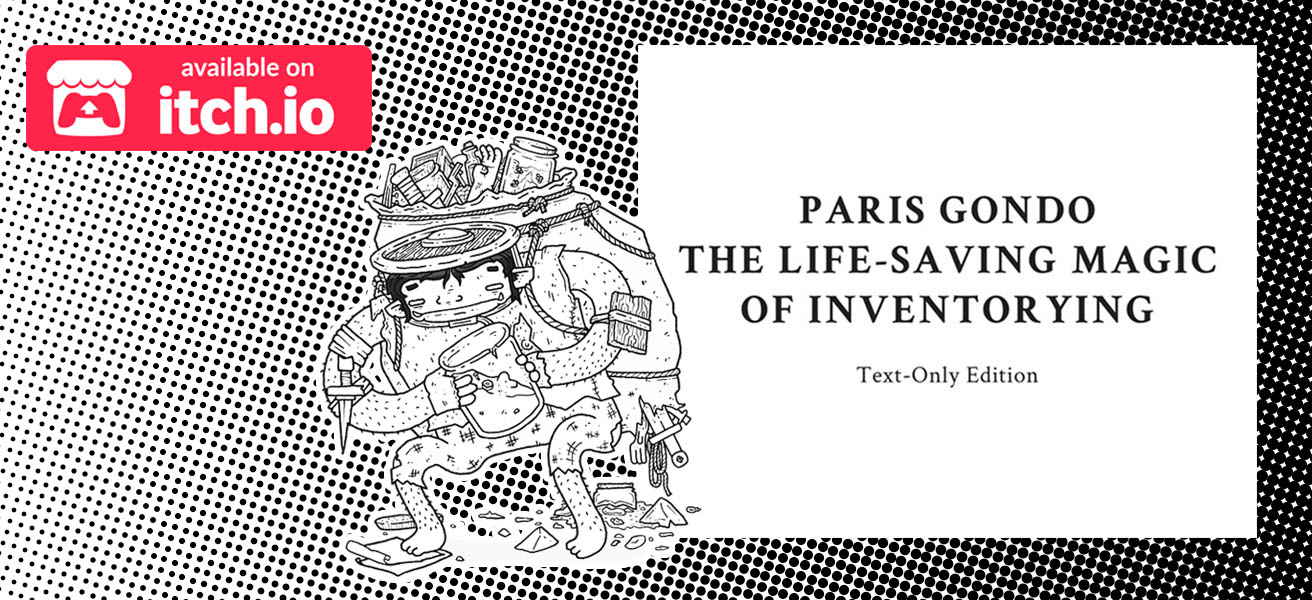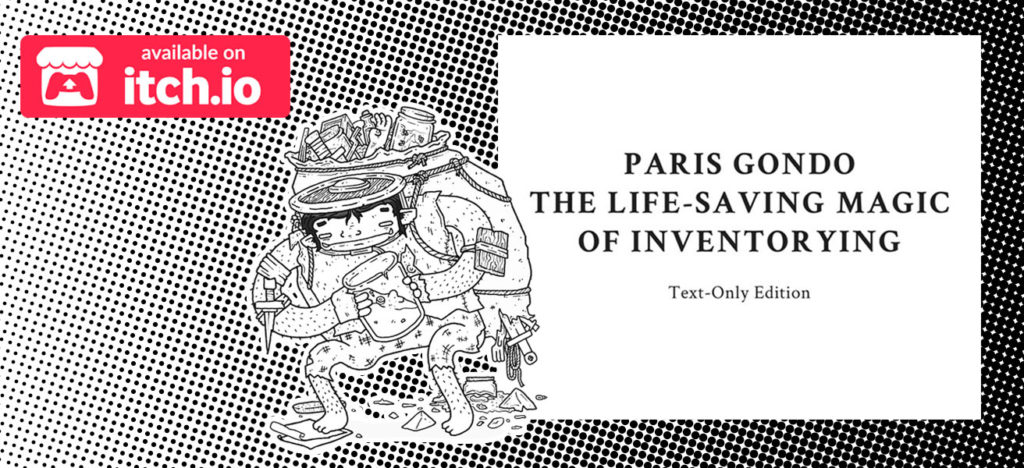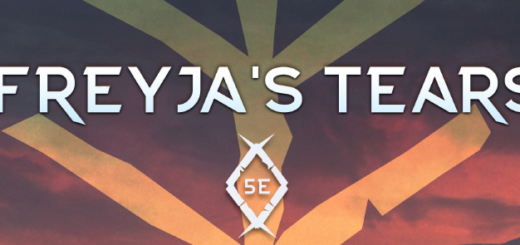Review of Paris Gondo – The Life-Saving Magic of Inventorying

In the last review we looked at the generic and small Tricube Tales. This time, it’s about what really sparks our joy. Kalum from the Rolistes Podcast sent us the text version of Paris Gondo – The Live-Saving Magic of Inventorying. I took a look at the role-playing game based on Marie Kondo’s decluttering technique.
Paris Gondo was sent to us by Kalum from the Rolistes Podcast. The text-only version of Paris Gondo was not tied to any review, but we do want to say a few words about it.

- Publisher: Rolistes Podcast / Kalum
- Release Date: 2021
- Language: English
- Pages: 94
- Format: PDF
- Price: 10 $ as PDF on itch.io
What’s the game about?
The game pays homage to rules regarding a character’s carrying capacity as well as other tropes that arise in games involving dungeons or dungeon crawling. The game itself is gm-less and requires no preparation.
In this game, the group starts after crossing the dungeon and defeating the final boss. They have captured the treasures that this person or creature has so carefully hoarded and the party must begin their journey home. The only problem with this is that some items might hinder them, be less useful, but cause more enjoyment for the characters. So it is to create a well-organised inventory, what is useful, not too heavy and sparks the most joy.
On the way there, the players describe the dungeon, why they set out there, who the bad guy in the dungeon was, how their group is made up, why they are travelling together and so on. The treasure is also described and the values of it, divided into encumbrance, usefulness and emotion, are rolled for each item.
On the journey home, the success of the return is then rolled. Will the adventurers make it back to civilisation in one piece? Did they choose the right items that will bring them joy or did they just take useless junk with them?
Testimonials from the Book
Here are some reviews that were once apprentices of Paris Gondo and the magic of inventory management:
“My husband and I are getting along much better.”
C. from King’s Landing
“I’m amazed to find that throwing things away has changed me so much.”
B. from the Shire
“I finally succeeded in losing three kilos.”
Y. from Vengerberg
Overview of the 6 steps of Paris Gondo
Paris Gondo is a narrative role-playing game. It does not need a game master, is not long (around two hours) and depends a lot on the creativity of the players. Except for the loot and character class, each player otherwise only rolls the dice three times in the game.
In each of these steps, there are texts to read aloud that come from Paris Gondo to introduce the GonParis method and thus guide everyone through the procedure.
Setup: Session Zero
In Session Zero, two important topics are clarified in advance: safety and spirit.
In Session Zero, safety methods are to be used so that everyone at the table has fun and feels comfortable. The X-Card is recommended, as well as the Spark Joy card. In case of the latter, this card is used with small tokens from the players if something in the game sparked joy and this should then be more encouraged.
The spirit should bring the players to a common idea of the round. Paris Gondo and the GonParis method is geared towards a fantasy setting, but whether the game round should be serious, dark, heroic or funny can be clarified here once again in advance. Paris Gondo is at its core a comical game that does not take itself too seriously, but here is the time to talk about it.
Step 1: The Dungeon
In the first step of the GonParis method, the dungeon is created. This happens through discussions in the group. Helpful questions could be:
- How is the dungeon designed and what does it look like?
- What circumstances led to the characters going into the dungeon?
- What dangers and obstacles stood in the way of the group?
- Who lives in this dungeon?
- Why do these creatures live in the dungeon?
- Who leads the creatures? Who is the boss in the dungeon?
- How or why did the adventurers get into a disagreement with the boss?
Further questions can arise in the course. There is no limit here. However, the hints and discussion contributions here can already lead to ideas for the loot.
Step 2: The Party
The next step is to describe the party. There are 6 classes:
- Barbarian
- Bard
- Cleric
- Fighter
- Rogue
- Wizard
Each class has its own card deck of starting items, as well as a maximum carrying capacity. Details such as name, appearance, motivation, personality, background and also the items in the starting inventory can be described. The latter, however, may not be changed by the values, i.e. may only involve cosmetic changes. A spell book can thus become a stone tablet, but the mechanical values must not change.
Afterwards, the characters are introduced to the group. The others can then ask questions about the character. Why is the character in the dungeon, how did the person survive for so long, what qualities does this character have, what personality? etc. The questions can also be about the starting inventory.
The final step for the group is how the group found and formed itself. All together at the table consider and discuss what brought the group together, what the dynamics are among themselves, what they have experienced so far, etc. Again, the items in the characters’ inventory should be picked up and woven into the story.
Step 3: The Loot
Slowly we get to the heart of the matter. The third step is all about the new loot that the adventurers obtain. Each player takes two loot cards and rolls a d6 to determine the encumbrance, usefulness and emotional value. Afterwards, the class for which this item is most suitable is thrown out. The usefulness value is doubled if the corresponding class has the item.
Then the item is described. The name should of course reflect the values of the object. This is how you can describe the “Immovable Mirror Shield” ;-).
The last step is to present the loot to the group. It is described how the object was found and how the character reacted to it. The other players can ask further questions about the object: What does the object look like, where did it come from, who did it belong to before? etc.
Step 4: The Life-Saving Magic of Inventorying
The GonParis method starts in exactly this step. We put all our items on the floor and re-sort our inventory. This process is, at its core, the exchange of items with the other members of the group. This exchange should be played out and thus also show scenes of negotiating over an item or sadly giving away a beloved loot. From a purely rules point of view, the inventory is calculated here. Since each item has a weight and each character a carrying capacity, it is necessary to see which items can be taken along. The difference between the maximum load and the total weight must be greater than 0. At the same time, care must be taken that not only items that spark joy are taken along for the journey home, but also useful items, because no one knows what problems may still arise on the return journey.
At the end of this phase of the GonParis method, the values for
- Encumbrance Factor (Difference between the maximum carrying capacity of the character and the total weight of the items carried.)
- Total Usefulness (sum of all usefulness of the items in the inventory)
- Total Emotion (sum of all emotional values of the items in the inventory)
are determined per character. These values are then shared with the group and the average party usefulness of the group’s items is calculated from them.
Step 5: The Journey Home
A few more things happen on the journey home. The adventurers do not find their way home without obstacles. Each person playing rolls a d20 here. This symbolises a random encounter or obstacle. If the result is above the average usefulness value of the group, the overcoming of the obstacle has not been successful for the active player. In case the roll is less than or equal to the average usefulness value, it is a success.
If the roll fails, the active person describes how their character is subject to a great calamity. An item that led to this disaster or was not helpful enough to avert it must be named and described. In the case of a success, such a scene is described, but with an object that solved or defused the situation and was thus helpful. The group alternates between failures and successes in their narratives until all players have described their scene.
Finally, it must be determined whether the own character escapes or is separated from the group. This is again done with a roll of 20. The encumbrance factor of the character is added to the roll. If the roll is over 9, the escape is successful. Each person playing the game then describes a scene that either enabled a successful escape through an object or an object led to the fate of the character being left behind and devoured by a threat.
Step 6: The Emotional Epilogue
Regardless of whether the journey home was successful or not, whether the character died or returned safely, the emotional epilogue now takes place. Will the characters find a happy and satisfied ending or feel unwell and unsatisfied?
The players roll a d20 against the emotional value of the items they are carrying. If they are at or below the value, they are successful. Depending on the outcome of the roll, they describe how unhappy they are to leave behind an item (failure) or how happy they are because they found it (success). Characters who have experienced a cruel fate recognise, in the dark dungeon they could not leave, or in the afterlife, their fate, but also may or may not enjoy an item they have obtained or left behind.
After that, more details about the further life or course of the characters can take place to complete the story.
Conclusion
When Kalum sent me this work and I read through the description, I thought it was very much a work of its own. I like the idea – based on Marie Kondo – and find it beautifully taken up and realised.
Still, in my eyes it is more of a mini-game and not something that will find a permanent place in my rounds. While that doesn’t always have to be the case, I found Paris Gondo – The Life-Saving Magic of Inventorying to be a nice game for a fun evening. I like the fact that it doesn’t require too many rules and is very much limited to the narrative component.
This allows you to tell really great stories and still clean up your inventory. Very cool are the packs of cards and the script, which explains the whole game in a few pages and guides the players through the procedure. It is also very cool that there is no need for a game master, so everyone can work out for themselves what really sparks their joy.
So if you’re looking for a mini-game to have a fun night out with friends, this game is unique in theme and will probably be a lot of fun!








